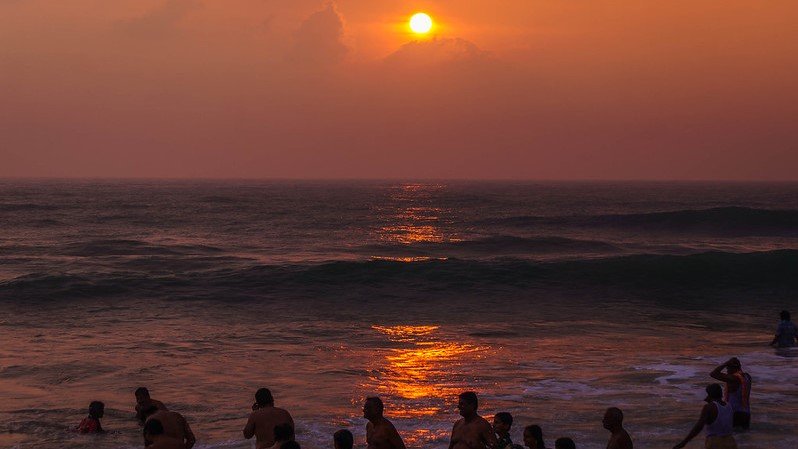Read in : தமிழ்
The buzz around wet bulb temperature has reached the Coromandel coast with cyclone Asani turning out to be only a brief interlude. The heat wave that has swept many parts of India in recent days, surpassing previously recorded peaks in April and May of 2010, has turned scientific attention to extreme humid heat, a silent killer that could produce a living hell for citizens along the eastern coastline, which includes a long stretch of Tamil Nadu.
In the recent wave, many centres in north India, including the national capital, were roiled by temperatures between 45 and 50 degrees C. These are traditional ‘dry bulb’ temperatures.
Extreme humid heat is measured in terms of wet bulb temperatures, calculated based on the dry temperature in a location and the humidity level there. The current understanding of the phenomenon is that if the wet bulb temperature exceeds 35 degrees C, it is impossible for human bodies evolved over millennia to adjust to it using their biological processes of thermoregulation. The result is fatal. The heat impact is lethal even among people having, as the scientific literature puts it, “idealised conditions of perfect health, total inactivity, full shade, absence of clothing, and unlimited drinking water.”
What should ring alarm bells for the Union government and for coastal States is the scientific view that eastern coastal India is already a hotspot for greater than 31 degree C wet bulb extreme humid heat temperature

A Wet Dry Hygrometer featuring a wet-bulb thermometer (Image credits: Crossmr Wikimedia Commons
What emerges from some recent research, explained below, is that this frightening scenario is not a distant prospect, but has already been reported in some parts of South Asia. These scary humid heat peaks escape scrutiny because of the averaging of weather station data that masks the experience of individual locations for parts of hot days.
According to a paper published by Colin Raymond and colleagues in the journal Science in 2020, “once the air (dry-bulb) temperature (T) rises above this threshold, metabolic heat can only be shed via sweat-based latent cooling, and at (wet bulb) TW exceeding about 35°C, this cooling mechanism loses its effectiveness altogether.” The human body has evolved to regulate body temperature by sweating, but that becomes dysfunctional at extreme humid heat – there is too much moisture around.
The scientists report that their survey of the climate record from station data had revealed instances of global wet bulb temperatures exceeding 31 and 33 degrees C, and two stations had reported multiple daily maximum values above 35°C. “These conditions, nearing or beyond prolonged human physiological tolerance, have mostly occurred only for 1- to 2-hours’ duration,” they write, and the episodes were concentrated in “South Asia, the coastal Middle East, and coastal southwest North America, in close proximity to extraordinarily high Sea Surface Temperatures (SSTs) and intense continental heat.”
The scientific forecast for wet bulb temperatures is that in the third quarter of the 21st century, South Asia could face regular episodes of 35 degrees C exceedances if globe-warming carbon dioxide emissions continue at present rates, with little net action by all countries to cut these gases. In the climate change literature of the IPCC, this falls under the RCP 8.5 scenario of high ‘business as usual’ emissions.
What should ring alarm bells for the Union government and for coastal States is the scientific view that eastern coastal India is already a hotspot for greater than 31 degree C wet bulb extreme humid heat temperature. By contrast, the evidence seems to indicate that western coast is so far an exception to the coastline rule, probably due to the way humid air is transported inland, the massive green cover in the Western Ghats producing evapotranspiration and widespread irrigation.
State governments should get a better grip on the issue through studies on health impacts of heat waves, especially on those pursuing outdoor vocations, among the elderly and those with compromised health conditions
El Nino impact
Moreover, there was a noticeable peak in the number of peak wet bulb temperatures globally (27 and 29 degrees C) during El Nino years such as 1998 and 2016. The analysis also has important pointers to the role played by a vigorous summer monsoon in regulating the moisture and therefore temperatures in the sub-continent.
The prognosis of this chronic disease afflicting the earth is depressing, since it projects as follows: with a 2.5 degree C warming of the world over pre-industrial era temperatures many instances of greater than 35 degrees C wet bulb temperatures will follow. Such a scenario will affect millions in the sub-continent, including the Tamil Nadu coast, who may be unable to achieve climate control and escape from extreme humid heat.
Governments need to heed the alarm call and approach the question of greenhouse gas cuts with redoubled vigour, rather than pay lip service to climate change mitigation. In parallel, State governments should get a better grip on the issue through studies on health impacts of heat waves, especially on those pursuing outdoor vocations, among the elderly and those with compromised health conditions.
It would also be important to understand the possibility of creating benign microclimates, through active greening and artificial wetland creation in populated spaces, going by the effect of both green cover along the western coastline of India, and the presence of large water bodies. New lakes in the core of cities may help. Nature-oriented reengineering of habitations along the eastern coastline may be actually inevitable, something that would be adversely affected by massive additions of heat-absorbing concrete in the form of buildings, roads and built structures.
Read in : தமிழ்
